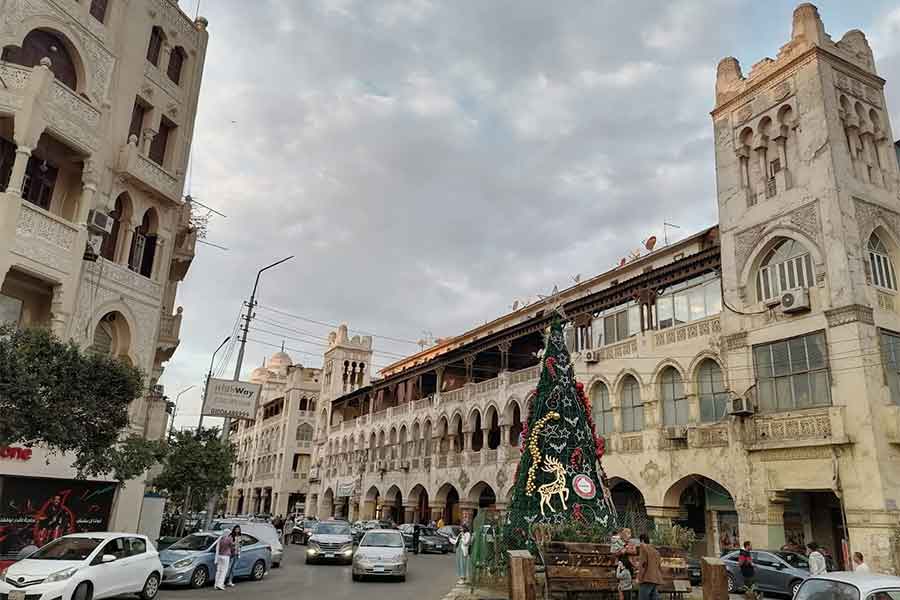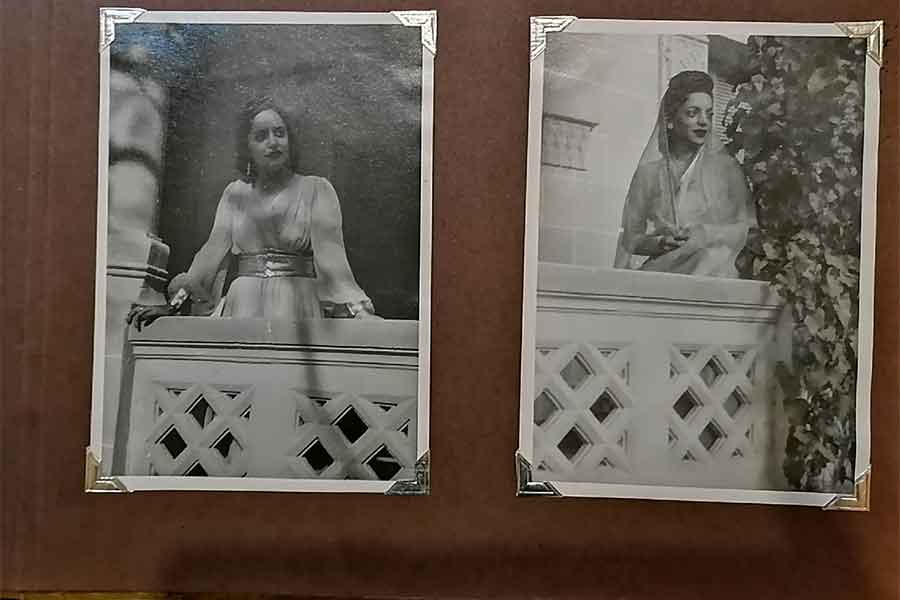We are the city. We are the hustle and bustle and those endless walks amidst ancient buildings leaning on trees that watched our grandparents grow. We are the streets that twist and turn, widen and narrow down to small allies that bare the treasure of time. We are those old songs that get remixed and never fall out of fashion. We are the city that owns the truth and all our versions of it.
----------
We start with Heliopolis, for it ain’t Christmas until Korba is dressed in Red, Gold and Green.
The charming 116 year old district of Heliopolis was the brain child of Baron Edouard Empain (1852-1929), a Belgian investor who came to Egypt at the end of the 19th century.
Its name – meaning Sun City – is derived from the district's location “on a site near the ruins of the old Heliopolis city," the "sun city” of ancient Egyptians," according to the a dissertation titled "The Garden Suburbs of Cairo: A Morphological Approach," by Mohammed El-Azzazi.
“Several architects designed Heliopolis, to name but a few: the French architects Ernest Jasper (1876-1940), Alexandre Marcel (1860-1928), Camille Robida (1880-1938), and the Belgian Léon Rolin (1871-1950),” reads the dissertation.

The Christmas tree at the center of Korba Square. Photo: Amira Noshokaty.
The first buildings went up in 1908 at the same time as the first tram route to Cairo was being opened. This tramline facilitated the daily journey of Heliopolis’ residents who worked in central Cairo, especially government employees.
The tramline also helped tourists arriving at Cairo’s main railway station from Alexandria visit the district, explains the book.
The most distinguished quarter of Heliopolis is Korba.
One can take long walks along elegant boulevards lined with buildings dressed in shades of yellow adorned with arches and curves. “This is the new-Islamic architecture,” explained Heidi Shalaby, head of central administration for planning and projects at the National Organization for Urban Harmony (NOUH).
“This is a unique style where European architects were inspired by the decorative Mamluk mosque architecture and decided to implement it on modern residential buildings, the main Heliopolis architectural style,” she added.
Korba got its name from “la courbe,” the curved line which the tramway used to follow along Baghdad Street, according to the thesis titled “Urban Space and Politics of Transition in Contemporary Cairo” by Mahy Mourad Nowier.
11 Ramsees Street

Handmade album with photos of Mrs. Basma Gregory as a little girl in her home garden. Courtesy of Mrs. Basma Gregory.
Mrs. Basma Gregory sat in the comfort of her distinguished living room against a background of an elegantly decorated Christmas tree with handmade photo albums piled next to her, and began to share her Korba memories.
She grew up in Heliopolis on Ramses street in Korba. The street, the oldest in Korba, was the residence of Egypt’s elite and prominent figures. It beheld several vast gardens that were lined with lavish villas. “It was also very quiet, to the extent that we use to recognize the footsteps of our neighbours as well as the sound of their cars, when we sat on the balconies at night,” Basma Gregory told Ahram Online.
“It was the residential area of all the Pashas. On one side, our neighbour was Al-Noqrashi Pasha (Egypt’s ex-prime minister), his daughter was our colleague at the American College for Girls and we used to take the same school bus. Their house was so beautiful they even had a gazelle as a pet and kept it in their garden. The villa on the left of ours belonged to [the statesman] Al-Shamsi Pasha, it’s where they filmed Gharam fel Karnak, starring Farida Fahmi and Mahmoud Reda,” she added.
The Gregory family’s house, villa number 11, was one of three villas on the same side of Ramsees street. It was a vast and beautiful Korba style house, around 2400 square metres owned by her maternal grandfather Habib Pasha Al-Masry, general secretary of Egyptian Senate, in 1943.
Al-Masry was a broadminded well cultured father who empowered his daughters and was among the few men who allowed their daughters to complete their studies abroad. Moreover, Eva Habib, Gregory’s aunt was the first Egyptian woman to attain a college degree from the American University in Cairo in 1924. Soraya, Gregory’s mother, was the artist of the family; she studied piano in Italy and when she returned she was a prominent figure in the art and culture community as well as the diplomatic one.

Basma Gregory's mother with her aunt at their terrace. Courtesy of Mrs. Basma Gregory.
This house witnessed the best of times. “We would sit on the balcony during summer nights and the sky was so clear you could see all the stars, and our aunt would teach us their names. In the afternoon, precisely at three pm, the ice-cream man would ring his bicycle bell and call out: ‘Groppi,’”she remembered.
The house also witnessed the worst of times. “Our garden was so big to the extent that during the Tripartite Aggression on Egypt in 1956, they hid several tanks on both ends of the garden under the trees. I remember how my sister and I went inside the tanks, how we used to hand pick the splinters of the bombs from the balcony and the garden. We were petrified. I remember Amoun, my husband, was fighting back then and he came home on foot; he walked 11 days from the borders of Israel to Ismailia, his whole platoon came back home walking.”

Basma Gregory's family. Courtesy of Mrs. Basma Gregory.
Sadly the many heirs of the house decided to sell it in 1972. Consequently, it was demolished and a tall modern building stands in its place nowadays.
“We used to walk to Home-Made Cakes (known now as Chantilly). It was the most famous patisserie in Heliopolis for ice-cream and cakes. We roller-skated at the Heliopolis skating hall behind cinema Roxy, whose open air cinema was our classic family outing in summer. “

A historic residential building in Korba. Photo by Amira Noshokaty.
Heliopolis has always been a cosmopolitan district; it resembled Alexandria to an extent. Even the churches here represent all Christian sects and the community celebrated all religious festivities with the same decorative enthusiasm.

“They used to light up the trees and streets in Korba square during Christmas, and during Ramadan, Ibrahim street was all lit up with Ramadan lanterns,” she recalls.
Among the most prominent members of cosmopolitan Heliopolis is Yves-Marie Deshays. Deshays is a renowned French Pianist and artist that was born in 1942 in Alexandria, Egypt, to a family of internationally known interior decorators.
He started piano lessons at the age of six and was only twelve years old when he played the organ for the first time at the Cathedral of Heliopolis. He shared with Ahram Online a photo of his beloved old Heliopolis.
“At the time — 1953-1956 — we lived in a little white one storey villa at the crossroads of Damiette St. and Imam Ali St., across from Saint George’s college, facing the Catholic Coptic church. I was able to visit it again before it was replaced by a huge building. And there is this photo of myself in 2019 at the organ of the Basilica, where I first played on 15 May 1955,” he said.

Share with us your favourite Heliopolis memory, photo and we will share it with the world: [email protected]
#own_the_city
Short link: